From Pony Express Hero to Civil War Casualty: Remembering Johnny Fry
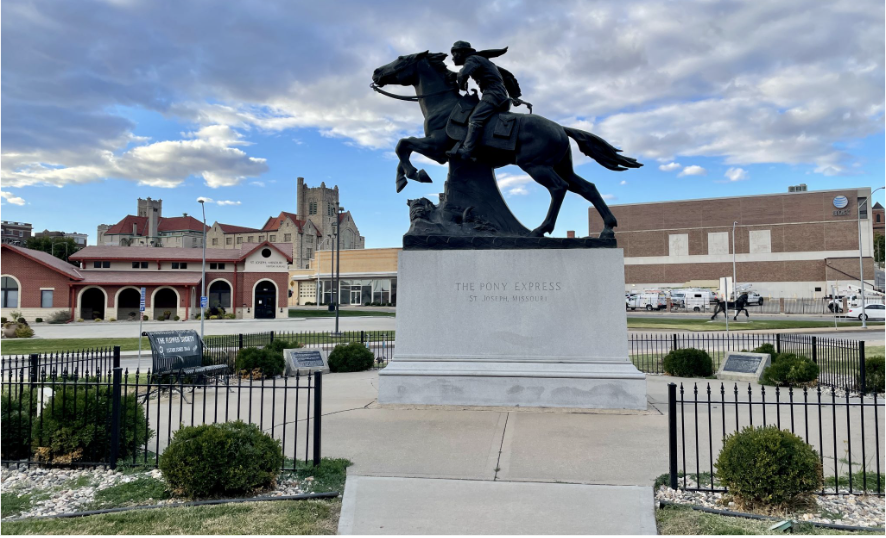
This year marks the 160th anniversary of many important Civil War battles – Chancellorsville, Vicksburg, Gettysburg, Chickamauga, and Chattanooga quickly come to mind. One that has received little attention, however, is the Battle of Baxter Springs, more commonly known as the Baxter Springs Massacre, where 103 Union soldiers were killed on October 6, 1863, in Baxter Springs, Kansas, by Quantrill’s Raiders.
So, why include a photo of the Pony Express statue in St. Joseph, Missouri, in a post about Baxter Springs? Because one of those killed was 23-year-old Johnny Fry, better known as the first rider of the Pony Express. I had a chance to learn a lot more about Fry and his roles in both the Pony Express and the Civil War when I visited St. Joseph, Missouri, last year. There, I toured the Pony Express Museum and the Patee House Museum, which served as the Pony Express Headquarters for the 18 months it was in service.
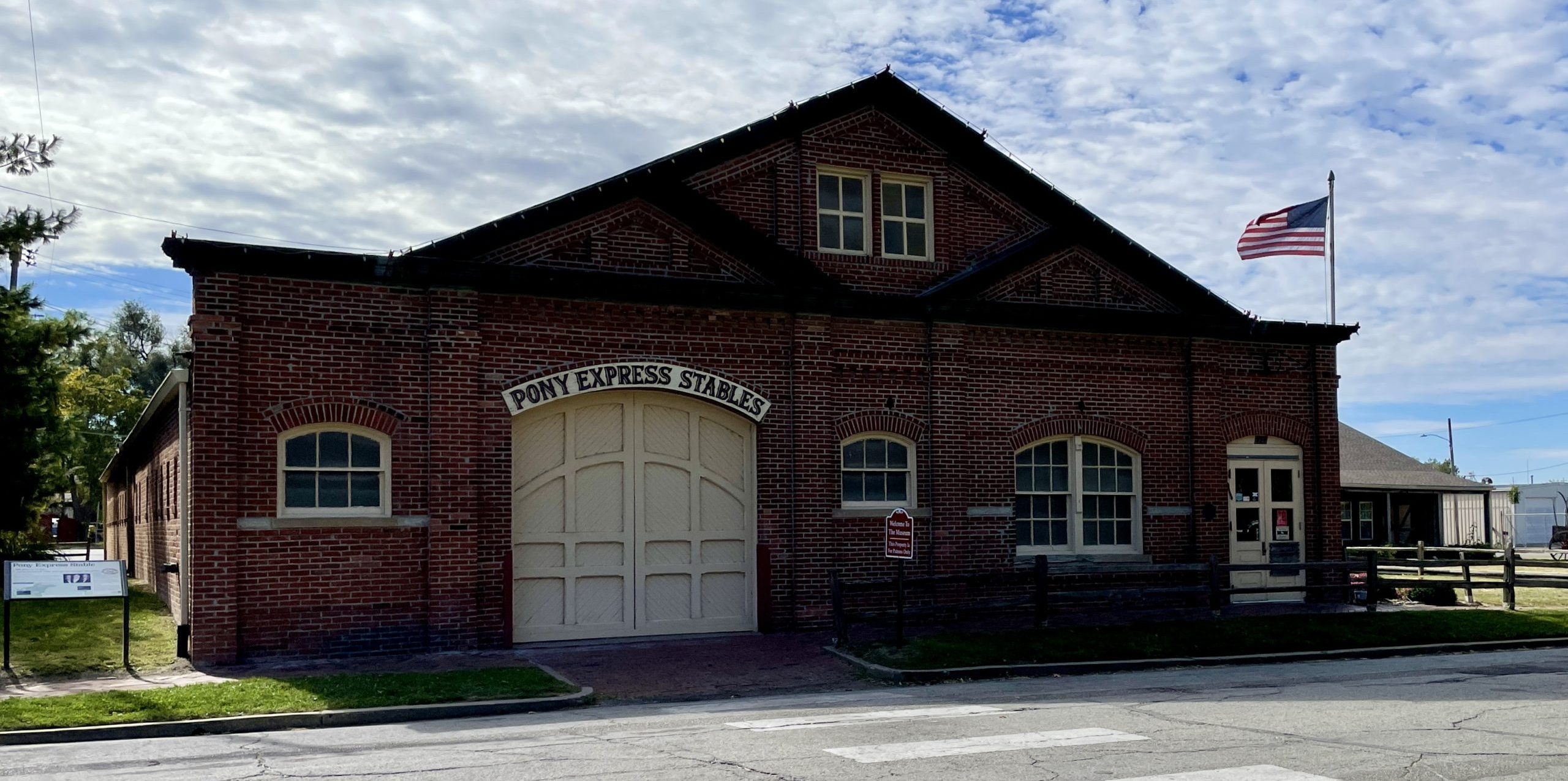
It was from the stable doors pictured above that on April 3, 1860, the 20-year-old, fast-riding Johnny Fry burst forth on his horse Sylph, ready to receive his first leather mochilla of mail to be delivered to California. That first saddlebag included a copy of the St. Joseph Gazette, 49 letters, and nine telegrams, mailed at a cost of $5 for a half-ounce letter – the equivalent of $160 today. [1]
A cannon alerted the crowds that Fry was setting off. Thousands watched and cheered as Fry raced through the streets of St. Joseph to the nearby Missouri River, where he boarded a ferry to cross into Elwood, Kansas. He then rode at breakneck speeds for eighty miles to the city of Seneca, Kansas, where another rider took over for the next leg of the journey. The goal was to deliver the mail to Sacramento, California, nearly 2,000 miles away, in just 10 days – much faster than the 25 days it typically took to deliver mail by stagecoach or several months by ship. Approximately 200 riders were hired, 400 horses purchased, and 165 stations built for this purpose.

Everyone watching that day knew the dangers of travel between St. Joseph and California at this time – and few dared to make that journey unless in large groups of armed men. The Pony Express riders traveled solo, crossing often rough terrain through inclement weather at speeds of 10-12 miles per hour. Ads in the newspaper looking for riders stated: “Wanted. Young, skinny, wiry fellows not over 18. Must be expert riders willing to risk death daily. Orphans preferred.” Most, as it turned out, were not orphans – but riders were typically young and skinny. Fry himself weighed less than 120 pounds. The youngest rider hired was eleven; the oldest, in his forties.
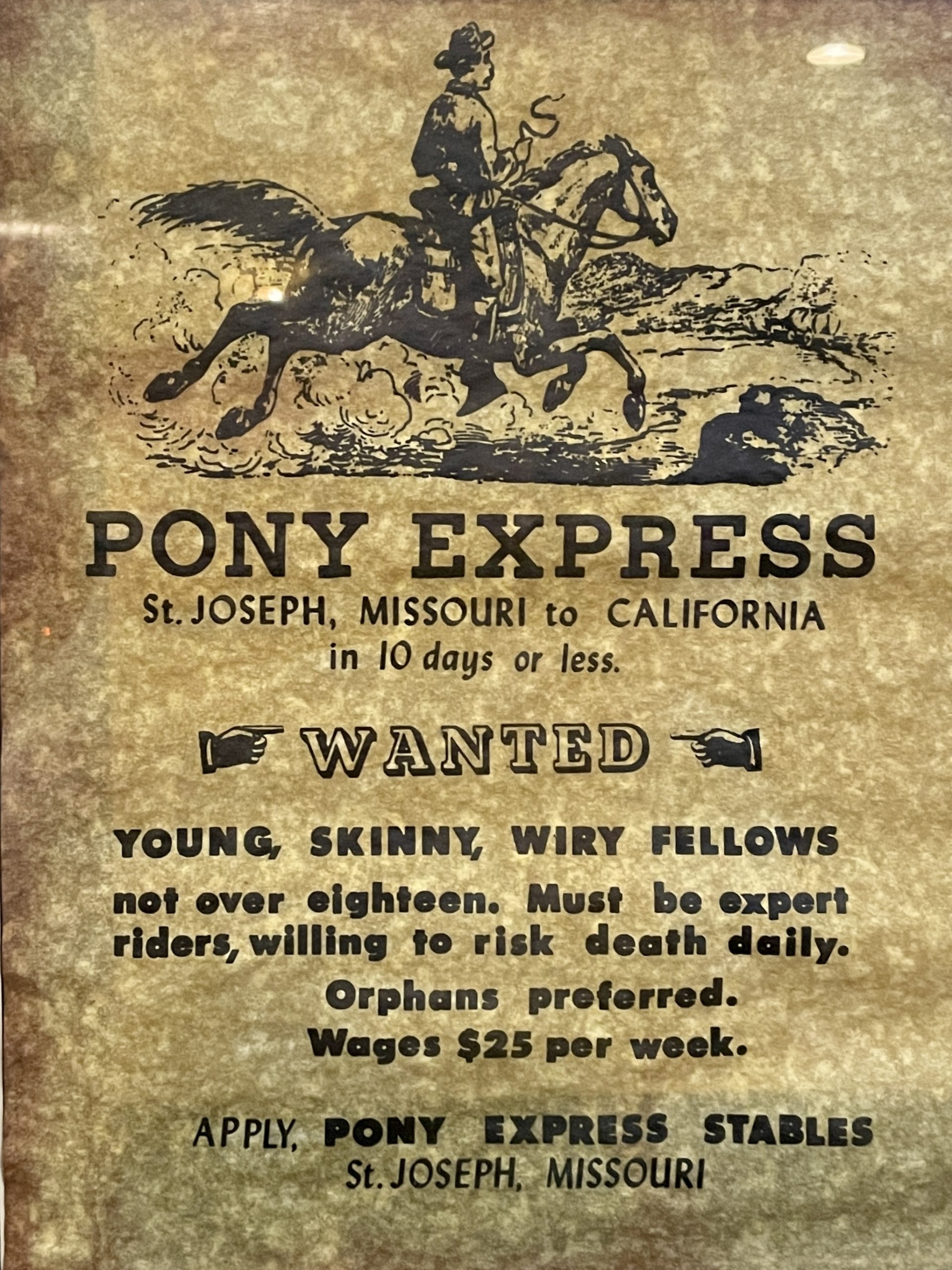
Crowds gathered again ten days later to watch Fry ride back into town, delivering the first eastbound mail from California. Bells rang, guns and cannons boomed, and bonfires lit up Main Street. As the New York Times described on April 14, 1860: “Citizens paraded the streets with bands of music, fireworks were set off … the best feeling was manifested by everybody.” [2] At the nearby Pony Express Headquarters in St. Joseph’s Patee Hotel, founders William H. Russell, Alexander Majors, and William B. Waddell – who owned the Central Overland California and Pikes Peak Express Company that operated the Pony Express – celebrated their success.

During the thirteen months that Fry rode for the Pony Express, he never failed in his duty to deliver the mail, and he gained many admirers along his route. According to one sign at the museum, “A story is told that some young women west of Troy, Kansas, would watch for him to make his Pony Express run past their homes so they could hand him cakes and cookies. Since he had to snatch them on the run, they decided to put holes in the center of the cakes and cookies which would make them easier for him to hold. This is one version of how doughnuts were created.” [3]
Someone else who played a key role in those early Pony Express celebrations was St. Joseph’s mayor Meriwether “Jeff” Thompson, who presided over the celebration, gave an enthusiastic opening day speech, and helped lay the leather mochilla of mail on Johnny Fry’s horse before his first ride. Ironically, on May 22 the following year, Thompson led a secessionist mob in tearing down an American flag that hung above the post office. [4] Soon after this, he and many other Confederates fled St. Joseph. Thompson went on to become a Confederate Brigadier General and earned the title of “Missouri’s Swamp Fox” due to his many successful raids on Union supplies and because he managed to emerge victorious in numerous skirmishes from seemingly impassable swamps. He, too, is commemorated in the Pony Express Museum with the painting seen here.
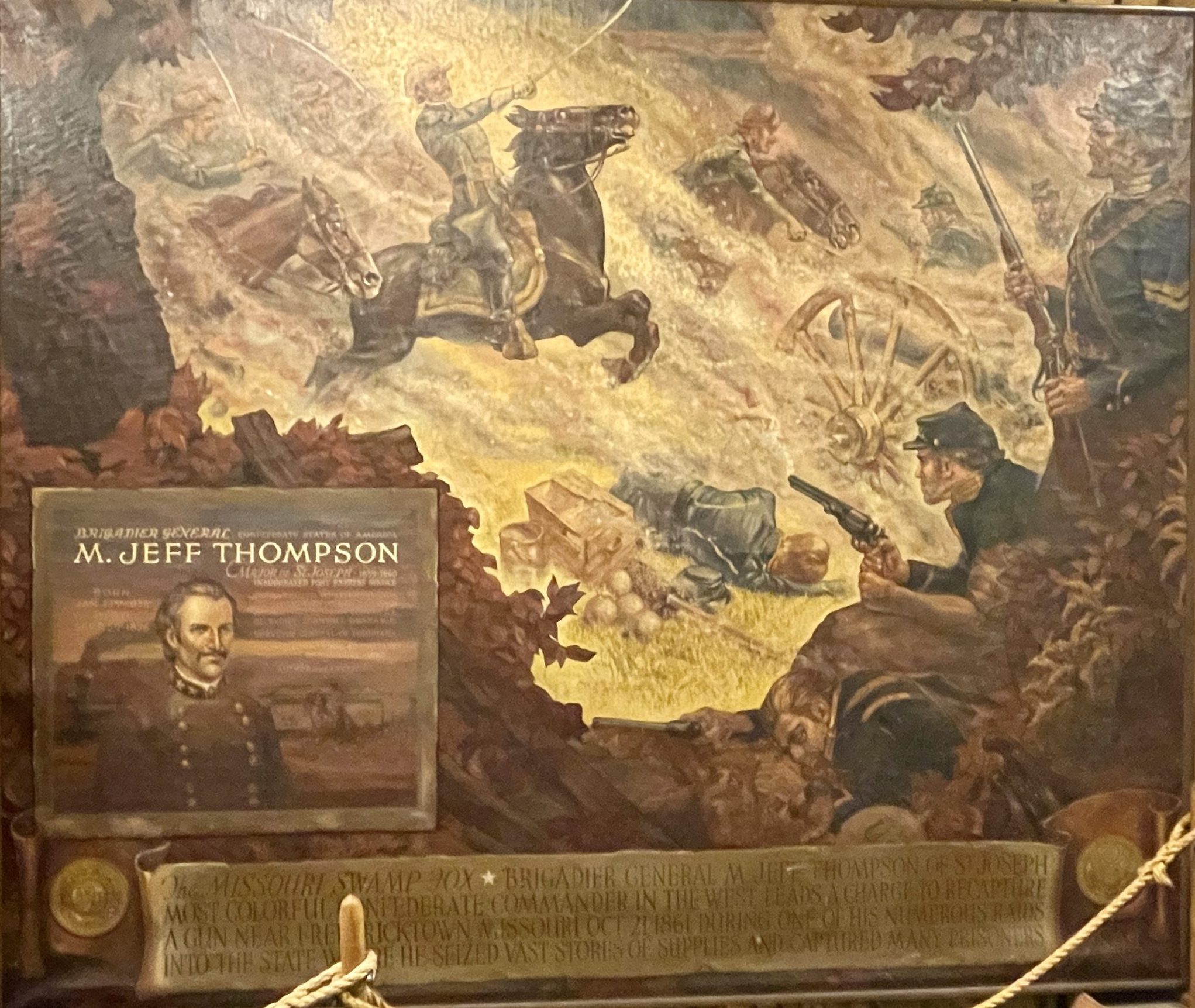
Some credit the Pony Express with helping to keep California and Oregon in the Union, for “the threat of Civil War made quick communication between East and West essential.” [5] It was the Pony Express riders who first delivered the news to California of Lincoln’s election and of the subsequent secession of the Southern states. And it was they who carried the news to the West of the firing on Fort Sumter in April 1861, doing so in a record eight days, fourteen hours.
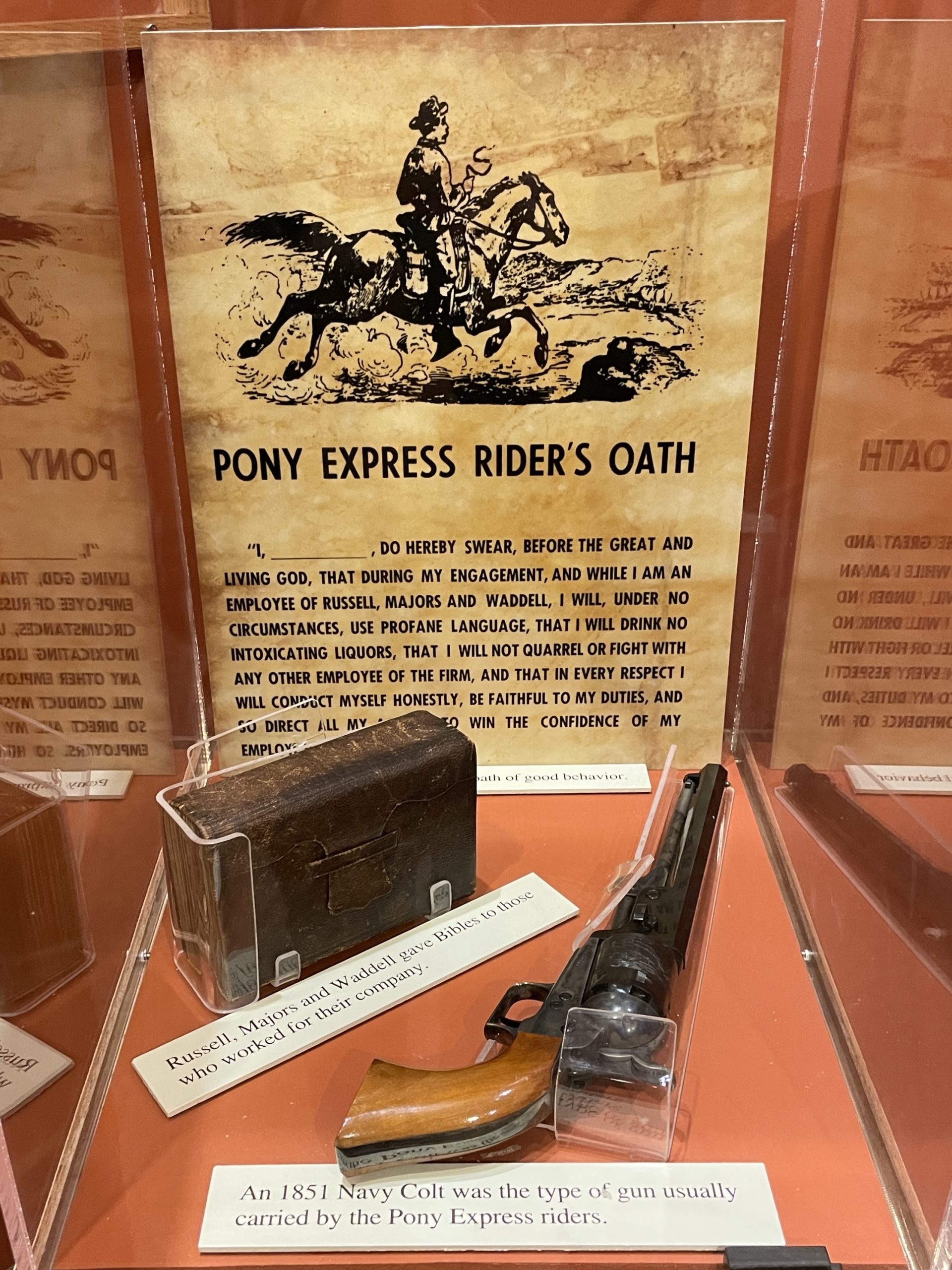
By October 1861, however, Russell, Majors, and Waddell’s Pony Express venture had gone bankrupt. They failed to win the $1 million government mail contract they had hoped to secure, and the completion of the first transcontinental telegraph on October 24, 1861, meant the Pony Express was no longer essential to communicating urgent news. It shut down on October 26.
Five months before its demise, in May 1863, Union Army General James G. Blunt recruited Johnny Fry to serve as a messenger and scout for the Union Cavalry. It was while serving in that role that Fry’s luck finally ran out. On his journey to deliver a message from Fort Gibson, Oklahoma, to Fort Scott, Kansas, William Quantrill and his gang of Confederate guerrillas caught up with him.
Quantrill and William “Bloody Bill” Anderson had led about 400 bushwhackers in a surprise attack on Lawrence, Kansas, on August 21, 1863. They had ridden into Lawrence, ransacked homes, killed civilians, looted businesses, and burned almost the whole town, killing more than 150 men and boys who were old enough to carry a rifle and leaving 85 women widows. [8]
Now, Quantrill and his men were traveling through Kansas on their way to their winter destination in Sherman, Texas. On October 6, however, they took a detour after hearing from two Union teamsters whom they captured and killed that a Union fort had been built nearby. With walls just four feet high, the earth-and-log Fort Blair, also known as Fort Baxter, was primarily being manned that day by about 50 black soldiers from the 2nd Kansas Colored Infantry under the command of Lt. Ralph Cook. Another 25 sick white soldiers under Lt. John Crites’s command from the 3rd Wisconsin Cavalry were also present, with another 60 out on a foraging mission.
Before reaching the fort, Quantrill and his men heard gunshots in the distance. Investigating, they came upon the unsuspecting Lt. Cook and “Pony Johnny” Fry firing their guns for target practice. Earlier, Fry had sought refuge at Fort Blair after narrowly escaping guerrilla Cy Gordon and five Creek Indians who had been pursuing him, but he told the men at the fort “that he had gotten his pistols wet when he swam the river, and wanted to shoot them empty, clean and reload them, before going on to Fort Scott.” [9] Cook volunteered to go with him; a third Wisconsin man joined them.
Only the Wisconsin man returned, relaying news of the attack and reporting that Fry killed five of his assailants before falling mortally wounded. The guerrillas “executed [both Fry and Cook] on the spot [and left] their bodies lying in the woods. When located the following day, their bodies had been riddled by so many many bullets, [it was] as if they were intended for target practice.” [10]
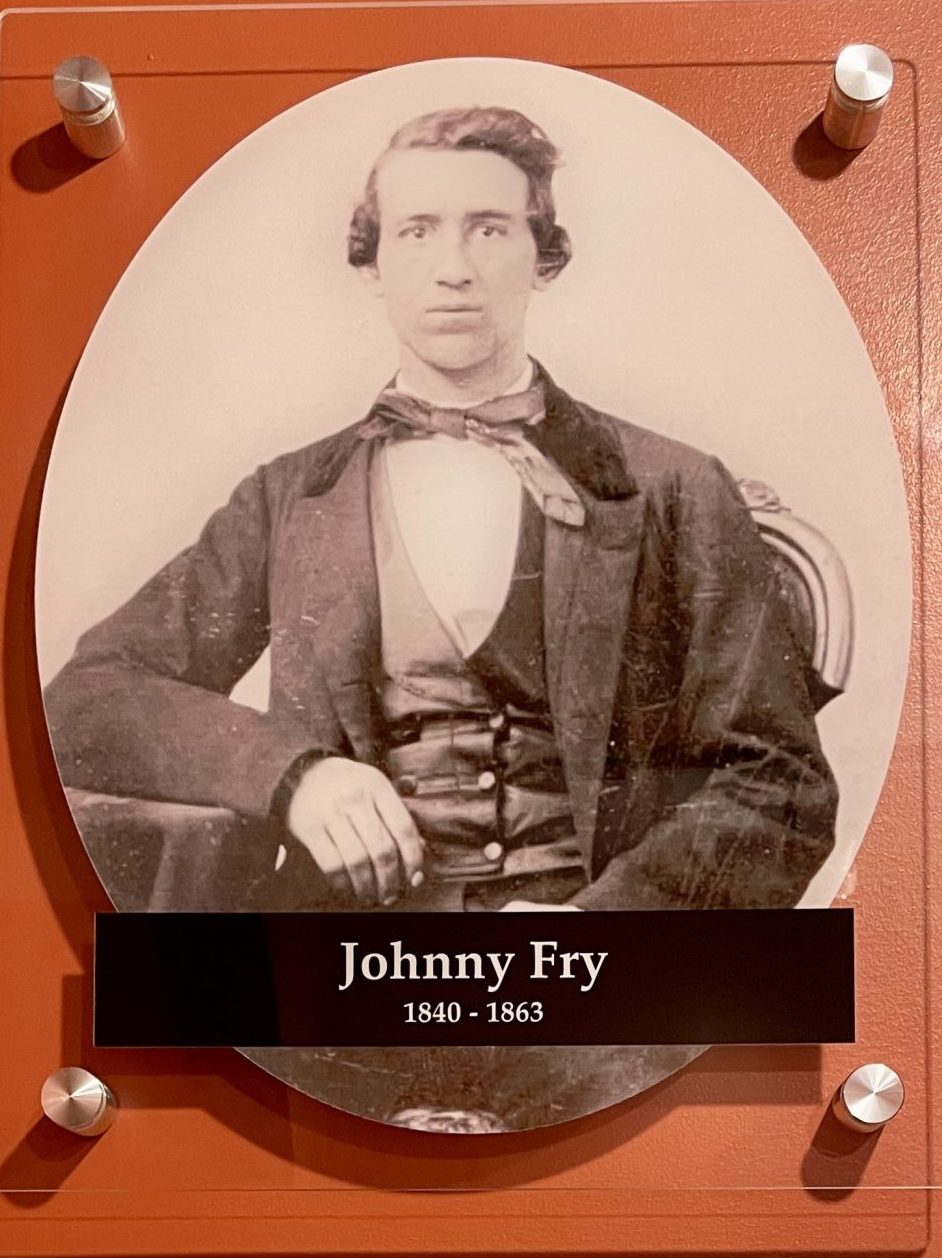
The guerrillas soon continued on to Fort Blair, where the unsuspecting Union soldiers were having lunch. As the guerrillas charged toward them from three sides, “the startled soldiers fled up the hill to the safety of the walls of the fort amidst a hail of wild, raucous, and a totally undisciplined enemy gunfire. Quantrill’s mounted attackers, although superior in numbers, were no match for the disciplined and determined sharp shooting black soldiers. The white soldiers, aroused from their sick bay, joined their black comrades, to take up arms. Black and white soldiers fought a common opponent in the trenches and throughout the fort site. This was indeed an event that set the Battle of Baxter Springs apart from battles being waged in the East. Black and white soldiers fought side by side, oblivious to color.” [11]
Fort Commander Lt. James G. Pond quickly took control of the situation, and with the help of a howitzer cannon he had brought with him to the fort two days earlier, the soldiers were able to save the fort and drive the guerrillas away. Pond later praised the 2nd Kansas Colored Infantry, saying, “They fought the best of any men I ever saw. Not one would give up after they were wounded, but kept shooting as long as they could see a rebel. I think that if our northern pro-slavery friends could serve a few weeks with a colored regiment and witness the soldierly-appearance, all prejudice against them would be removed.” [12]
Quantrill and his men next attacked a nearby detachment of Union soldiers helping to move Maj. Gen. Blunt from his former headquarters in Fort Scott, Kansas, to his new one at Fort Smith, Arkansas. In what would become known as the Baxter Springs Massacre, the guerrillas killed nearly 100 Union soldiers, including Maj. Henry Curtis, the son of Maj. Gen. Samuel R. Curtis; a brigade band; and writer and artist James O’Neill, a correspondent for Frank Leslie’s Illustrated Newspaper. A Union search patrol the following day found bodies “strewn over a wide distance … [as the] massacre occurred over several square miles of prairie,” and discovered the guerrillas “scavenged every item they could find in the wagons, taking virtually everything of value.” [13]
Blunt survived the attack, but he lost most of his men, and the Confederates “made off with Blunt’s clothing, sword, commissions, correspondence, official papers and a flag the ladies of Leavenworth, Kansas, had presented to him four days earlier.” [14] Soon after, he was removed from command for failing to protect his men, though he was later restored to a leadership role.
Historical accounts of the Battle of Baxter Springs differ in the total number they report dead in the fighting at the fort, the killings beforehand, and the massacre. Most of those killed, including Fry, were initially buried north of the fort in a common grave. Later, however, their bodies were moved to the Baxter Springs National Plot. And there, in 1886, a 20-foot high monument topped by a marble statue of a Union soldier was dedicated, inscribed with the names of 132 Union soldiers and officers killed during the Battle of Baxter Springs. Four 1853 mounted cannons surround the monument, one at each corner. [15]
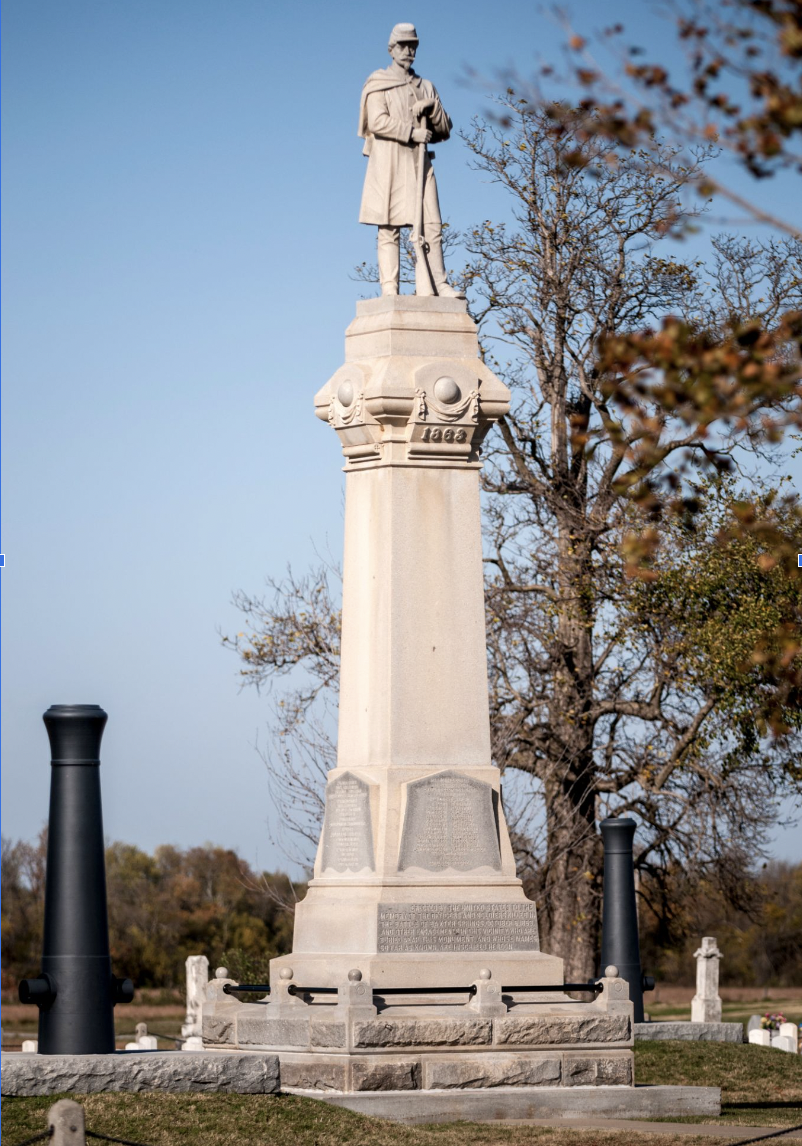
Endnotes:
- Andrews, Evan. 10 Things You May Not Know About the Pony Express | HISTORY, 3 June 2016, https://www.history.com/news/10-things-you-may-not-know-about-the-pony-express.
- “The First Ride on the Pony Express (U.S.” National Park Service, 30 January 2021, https://www.nps.gov/articles/000/the-first-ride-on-the-pony-express.htm.
- “Johnny Fry Exhibit Sign.” Photo by Tonya McQuade. Pony Express Museum, St. Joseph, Missouri, 14 Oct 2022.
- “Meriwether Jeff Thompson.” The Civil War in Missouri, http://www.civilwarmo.org/educators/resources/info-sheets/meriwether-jeff-thompson.
- Fischer, William. “The Civil War in St. Joseph Historical Marker.” The Historical Marker Database, https://www.hmdb.org/m.asp?m=48063.
- “Pony Express Rider’s Oath.” Photo by Tonya McQuade. Pony Express Museum, St. Joseph, Missouri, 14 Oct 2022.
- Fischer, William. “The Civil War in St. Joseph Historical Marker.” The Historical Marker Database, https://www.hmdb.org/m.asp?m=48063.
- Epps, Kristen. “Quantrill’s Raid on Lawrence.” Civil War on the Western Border, 5 June 2015, https://civilwaronthewesternborder.org/encyclopedia/quantrills-raid-lawrence.
- “The Story of Johnny Fry – Feb 18, 2020 -.” MyTripJournal, 18 February 2020, http://www.mytripjournal.com/travel-905401-johnny-fry-baxter-springs-pony-express-joseph-museum.
- “The Day of Conflict – Civil War.” Baxter Springs Heritage Center and Museum, http://www.baxterspringsmuseum.org/Civil-War.html.
- “The Day of Conflict – Civil War.” Baxter Springs Heritage Center and Museum, http://www.baxterspringsmuseum.org/Civil-War.html.
- “The Day of Conflict – Civil War.” Baxter Springs Heritage Center and Museum, http://www.baxterspringsmuseum.org/Civil-War.html.
- “The Day of Conflict – Civil War.” Baxter Springs Heritage Center and Museum, http://www.baxterspringsmuseum.org/Civil-War.html.
- Etcheson, Nicole, and Errol Morris. “Massacre at Baxter Springs – The New York Times.” The New York Times Web Archive, 7 October 2013, https://archive.nytimes.com/opinionator.blogs.nytimes.com/2013/10/07/massacre-at-baxter-springs/.
- “Baxter Springs City Cemetery – Baxter Springs KS, 66713.” Kansas Tourism, https://www.travelks.com/listing/baxter-springs-city-cemetery/47916/.
Excellent introduction of the Pony Express, one of its most famous riders, and the brief tenure of that communications company. One further connection of the Pony Express to events that led to Civil War: John Floyd and the misappropriated Indian Bonds. Involving William H. Russell (Pony Express) and a clerk for the Interior Department named Godard Bailey, $800 000 in bonds held in trust for the Indians by the Department of the Interior “were removed” during the waning months of 1860 and given to Russell to be used as security on Pony Express loans. Secretary of War John Floyd, later criticized “for sending vast stocks of arms South” just months before Civil War erupted, apparently approved the diversion of funds. Floyd resigned as Secretary of War in December 1860 (and emerged a short time later as Major General in Confederate service); Bailey avoided jail by revealing all that he knew to a House of Representatives Inquiry; the Pony Express went bankrupt a few months later; the $800 000 worth of Indian Bonds “disappeared.”
Thanks for the added info – I definitely had a lot more I could have said about the Pony Express and its founders, but I knew I needed to bring the focus back to the Civil War connection before the article got too long. Russell, too, avoided prosecution and was freed on a technicality, helped by the outbreak of the Civil War. The whole episode is another sad example, though, of how our government let down Native Americans – I wonder how many went hungry or suffered in other ways due to the loss of those Indian bonds.